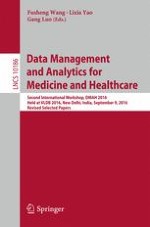This book constitutes the thoroughly refereed post-conference proceedings of the Second International Workshop on Data Management and Analytics for Medicine and Healthcare, DMAH 2016, in New Delhi, India, in September 2016, held in conjunction with the 42nd International Conference on Very Large Data Bases, VLDB 2016.
The 7 revised full papers presented together with 2 invited papers and 3 keynote abstracts were carefully reviewed and selected from 11 initial submissions. The papers are organized in topical sections on knowledge discovery of biomedical data; managing, querying and processing of medical image data; information extraction and data integration for biomedical data; and health information systems.
